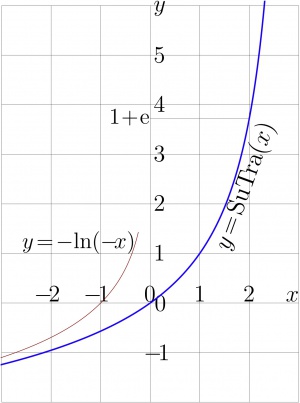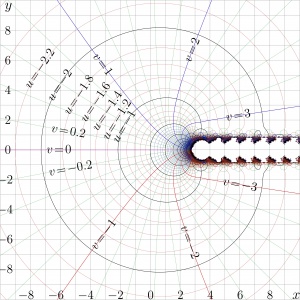SuTra
SuTra, or SuperTrappmann function is superfunction [1] of the Trappmann function, \(~\mathrm{tra}(z)=z+\exp(z)~\).
Function SuTra is intersting as it is entire and behaves as \(z\rightarrow -\ln(-z)\) at large \(z\) for the most of \(\arg(z)\), id set, in the whole complex plane except the strip along the real axis [2].
Properties and evaluation
The Trappmann function is treated as the transfer function; and the SuTra function, as superfunction of tra, satisfies the transfer equation
(1) \(~ ~ ~ \mathrm{SuTra}(z\!+\!1) = \mathrm{tra}\Big( \mathrm{SuTra}(z)\Big)\)
In orfer to narrow the set of solutions, it is assumed, that
(2) \(~ ~ ~ \mathrm{SuTra}(z^*) = \mathrm{SuTra}(z)^* ~ ~\), \(~ ~ ~ \mathrm{SuTra}(0) = 0 \)
and that SuTra is entire function.
For any positive \(\varepsilon\), at \(~|\arg(z)|>\varepsilon\), \( |z| \rightarrow \infty\), SuTra has logarithmic asymptotic behavior
(4) \(~ ~ ~ \mathrm{SuTra(z)} \sim -\ln(-z)\)
The corresponding asymptotic expansion is considered in the next section.
Expansion
At large negative values of the real part of the argument, the superfunction of tra can be approximated as follows
(4.0) \( ~ ~ ~ \displaystyle F_M(z)=-\ln(-z)+\sum_{m=1}^M \frac{\sum_{n=0}^m a_{m,n} \ln(-z)^n}{z^m} \)
for some natural number \(M\). It is convenient to choose \(a_{1,0}=0~\). For this case, the first coefficients \(a_{m,n}\) are shown in the table below
\( %\displaystyle \begin{array}{c|c|c|c|c|c|c|c} \displaystyle \begin{array}{cccccccc} \!\!a_{m,n}\!\! & n=0 & n=1 & n=2 & n=3 & n=4 & n=5 & n=6\\ ~ m %\backslash \\ ~1 & 0 & -1/2\\ ~2 & 1/6 & -1/4 & 1/8\\ ~3 & 7/48 & -7/24 & 3/16& -1/24\\ ~4 & 647/4320 & -35/96 & 5/16 & -11/96 & 1/64\\ ~5 &1427/8640 & - 4163/8640 & 25/48 & - 17/64 & 25/384 & - 1/160\\ ~6 &\! 1380863/7257600 \!& - 1883/2880 & 5963/6912 &\! - 653/1152 \!&\! 305/1536 \!& - 137/3840 & 1/384 \end{array} \)
For example, with 3 terms in the sum, id est, with \(M=3\), the asymptotic expansion of superfunction of tra can be written as follows:
(4) \( ~ ~ ~ \displaystyle F(z) ~=~ -\ell ~ - \frac{\frac{1}{2}\ell}{z}~ + \frac{ \frac{1}{6} - \frac{1}{4}\ell + \frac{1}{8} \ell^2 }{z^2} ~ + \frac{ \frac{7}{48} -\frac{7}{24} \ell +\frac{3}{16} \ell^2 - \frac{1}{24} \ell^3}{z^3} ~ + \mathcal O\left( \frac{\ell^4}{z^4} \right) \)
where \(\ell=\ln(-z)\). This asymptotes representation is valid at least for large negative values of \(\Im(z)\).
Coefficicients \(a\) in the expansion (4.0) can be calculated, substituting it into the transfer equation. In particular, the first terms of the expansion above can be calcualted with the Mathematica code below:
Clear [n, m, M, T]
tra[z_] = z + Exp[z]
P[m_, L_] := Sum[a[m, n] L^n, {n, 0, m}]
P[m, L]
F[z_] = -Log[-z] + a[1, 1] Log[-z]/z + Sum[ P[m, Log[-z]]/z^m, {m, 2, M}]
M = 4;
F1x = F[-1/x + 1]
Ftx = tra[F[-1/x]]
s[1] = Series[F1x - Ftx, {x, 0, 2}]
t[1] = Extract[Solve [Coefficient[s[1], x^2] == 0, {a[1, 1]}], 1]
A[1, 1] = ReplaceAll[a[1, 1], t[1]]
s[2] = ReplaceAll[Series[F1x - Ftx, {x, 0, 3}], a[1, 1] -> A[1, 1]]
t[2] = ReplaceAll[s[2], Log[x] -> L]
u[2] = Coefficient[t[2], x^3]
v[2, n_] := Coefficient[u[2] L, L^(n + 1)]
r[2] = Extract[ Solve[{v[2, 0]==0, v[2, 1]==0, v[2, 2]==0}, {a[2, 0], a[2, 1], a[2, 2]} ], 1]
For[n = 0, n < 3, A[2, n] = ReplaceAll[a[2, n], r[2]]; Print["A[2,", n, "]=", A[2, n]] ; n++;]
F[2, z_] = ReplaceAll[ F[z], {a[1, 1] -> A[1, 1], a[2, 0] -> A[2, 0], a[2, 1] -> A[2, 1], a[2, 1] -> A[2, 2]}]
In order to simplify the tracing of the code, the coefficient are calculated one by one. In order to get many terms, the appropriate loops should be organized. With a ten of terms, at \(\Re(z)<-20\), the approximation (4.1) provides of order of 15 correct significant figures, and the dragging to vivinity the origin of coordinate (iterating the transfer equation) provides of order of 14 decimal digits. This is close to the limit that can be achieved with the complex(double) variables.
Definition
WIth the asymptotic expansion above, function SuTra can be defined as follows.
Let \(F_m\) be function by (4) with series cut at the \(m\)th term. Then, for any complex \(z\) and some positive integer \(m\) function SuTra can be defined with
(5.1) \( ~ ~ ~ \displaystyle \mathrm{\tilde SuTra}(z)=\lim_{n \rightarrow \infty} \mathrm{tra}^n\big(F_M(z-n) \big) \)
(5.1) \( ~ ~ ~ \displaystyle \mathrm{ SuTra}(z)=\mathrm{ \tilde SuTra}(x_1+z) \)
where \(x_1\) is solution of equation \(\mathrm{\tilde SuTra}(x_1)=1\). While \(F\) is asymptotic solution of the transfer equation, the resulting SuTra does not depend on number \(M\) of terms kept in (4) for the \(F_M\).
Function SuTra is the only superfunction of function tra with such a behaviour.
The plot of the SuTra is shown in Figure 1. For comparison, its asymptotic \(~u\!=\!-\!\ln(-x)~\) is shown with thin line. The complex map of the SuTra is shown in Figure 2.
History
The Trappmann function, \(~\mathrm{tra}(z)=z+\exp(z)~\), had been suggested in 2011 by Henryk Trappmann as an example of a transfer function, for which it is difficult to construct the superfunction. For this reason, the Trappmann function is called after his name.
However, the superfunction of the Trappmann function, id est, SuTra can be expressed through that of the function zex, \(~\mathrm{zex}(z)=\mathrm{ArcLambertW}(z)=z\,\exp(z)\), in the following way:
(6) \(~ ~ ~ \mathrm{SuTra}(z)=\ln\Big( \mathrm{SuZex}(z)\Big)\)
at least for \(z\) outside the strip (3). Perhaps, the similar representation could be used also for values inside that strip with appropriate choice of branch of the logarithmic function. Practically, it is easier to use the transfer equation (1) recurrently, bringing the argument of SuTra to the range there the representation (6) is valid. In such a way function SuTra is implemented in the C++ algorithm SuTra.cin for plotting of the complex map in Figure 1.
Inverse function
The inverse function of SuTra, id est, AuTra\(=\)SuTra\(^{-1}\), satisfies the Abel equation
\(\mathrm{AuTra}(\mathrm{tra}(z))=\mathrm{AuTra}(z) + 1\)
AuTra has two branch points and two cut lines. These branch points correspond to the zero derivatives of SuTra.
The expansion for AuTra at large values of the argument can be found, inverting the expamsion for SuTra.
Iteration of the Trappmann function
The Trappmann function is important example of function without fixed points. Such functions were expected to be difficult for construction of the fractional iterates. However, due to expression (5), the iterates of the Trappmann function can be expressed with general formula
(7) \(~ ~ ~ \mathrm{Tra}^n(z)=\mathrm{SuTra}\Big( n+ \mathrm{AuTra}(z)\Big)\)
where AuTra\(\,=\!\mathrm{SuTra}^{-1}\) is the Abel function for the Trappmann function; the number \(n\) of iteration in expression (7) has no need to be integer. As usually, the superfunction can be iterated any real (can even complex) number of times.
Relation to other special functions
In certain range of values of the argument, and, in particular, along the real axis, The SupetTrappmann function SuTra and the AbelTrappmann function AuTra can be expressed through functions SuZex and AuZex, which are superfunction and the Abel function for the transfer function zex, \(\mathrm{zex}(z)=z\exp(z)\); at least in some vicinity of the real axis, the following relations hold:
(8) \(~ ~ ~ \mathrm{SuTra}(z)=\ln\Big( \mathrm{SuZex} (z)\Big)\)
(9) \(~ ~ ~ \mathrm{AuTra}(z)=\mathrm{AuZex}\Big(\exp(z)\Big)\)
Rlations (8) and (9) can be used also to calculate the expansions at large values of the argument, as well as for the numerical implementations of these functions.
References
- ↑ http://www.springerlink.com/content/qt31671237421111/fulltext.pdf?page=1 D.Kouznetsov, H.Trappmann. Superfunctions and square root of factorial. Moscow University Physics Bulletin, 2010, v.65, No.1, p.6-12. (Russian version: p.8-14)
- ↑ http://www.m-hikari.com/ams/ams-2013/ams-129-132-2013/kouznetsovAMS129-132-2013.pdf D.Kouznetsov. Entire Function with Logarithmic Asymptotic. Applied Mathematical Sciences, Vol. 7, 2013, no. 131, 6527 - 6541
Keywords
Trappmann function, SuperFunction, Zex, SuZex, AuTra, Iteration

